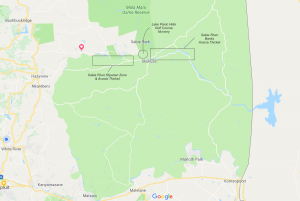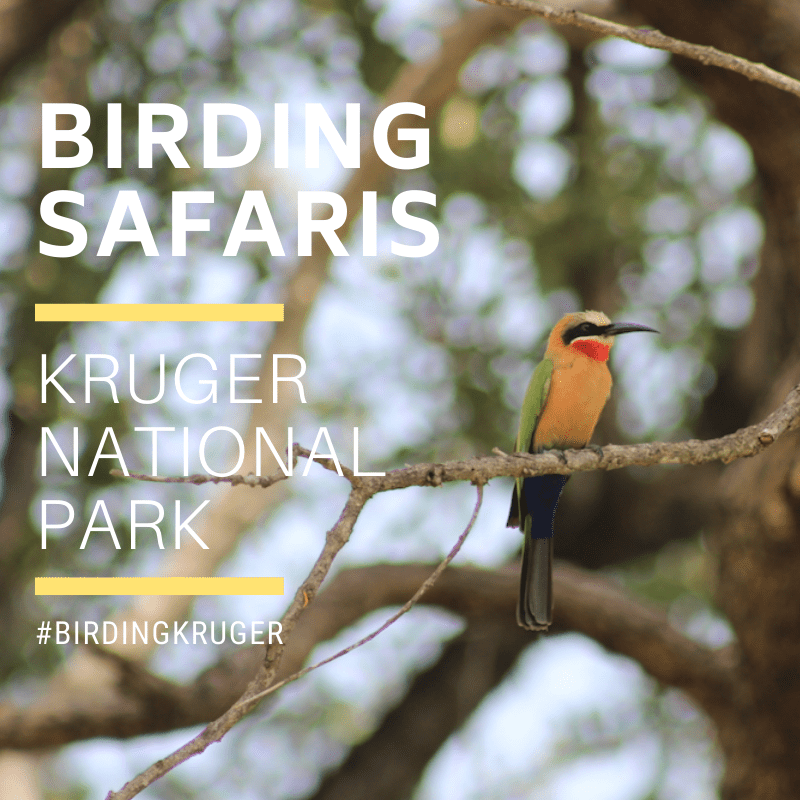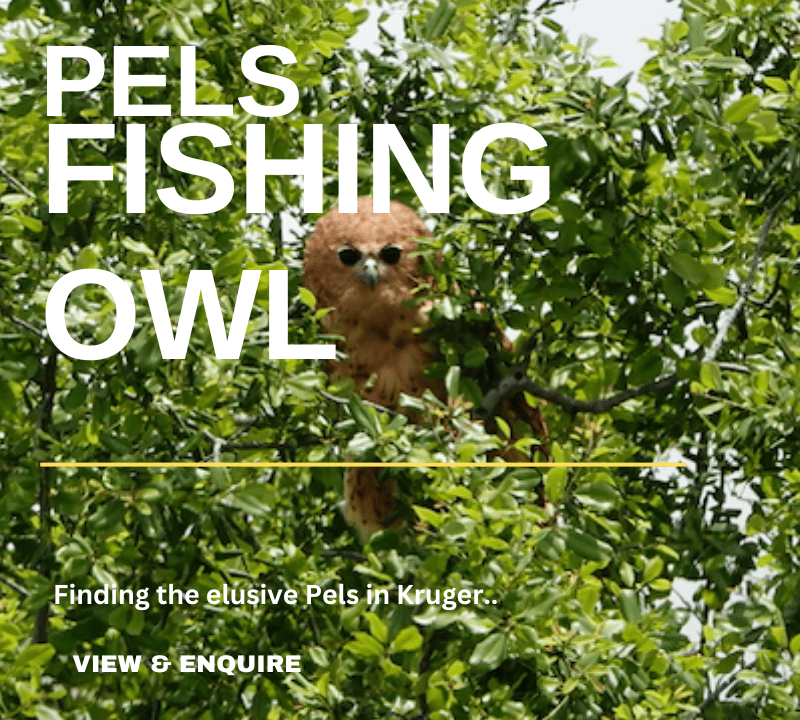
Birding Safari Kruger National Park
Birding the Southern Region
With the Southern region of the Kruger National Park representing some of the most bio-diverse flora within the 20,000sqm kilometers, it is a particular productive area to go in search of the Kruger Parks 520 recorded birds species. Naturally this is season dependent but following the Sabie River (from the Swazi word Sabisa meaning “to be careful” because of the slipper rocks and crocodiles) between Skukuza and Lower Sabie, a Birding Safari can be richly rewarded as the savanna provides diverse systems to explore. The main road although busy, straddles many different eco-zones providing an interesting mixture of flora.
North of Lower Sabie on the eastern bank of the Sabie River lies an extensive range of sweet grasslands proving ample opportunity to go in search of the many grassland non-passerine species ranging from spur fowl to bustard and korhaans. There is also the possibility of spotting the rarer quails and button-quails.
Staying along the Sabie River front and following the riparian zone of large trees, this is a great vantage point to view some of typical water birds and waders in the Park. There is also the likely chance of viewing many of the larger raptors and aerial scavengers within the river bed or perching in the large trees. These include Vultures, Eagles and Storks.
Within the near vicinity of Skukuza Camp the bush thickens into a deep acacia thorn thick and this provides wonderful habitat for many of the smaller and more colorful birds from waxbills to bush-shrikes, eremomela, pytilia’s and twinspots. A particular favorite of ours is to visit Lake Panic , the Skukuza Golf Course as well as nursery. This gives us the opportunity to leave our vehicle and go on foot in search of some of the species that dominate the thickets. Of particular interest in these areas are the ever elusive Gorgeous Bush Shrike and Narina Trogon. In the summer months one can spend an entire day just in these specific areas. With many large fruiting and flower trees and bushes there is a tremendous foot supply for both the frugivours and insectivorous species. A Birding Safari in the Kruger National Park wouldn’t be complete without visiting Lake Panic. This rather famous location provides all year round water and offers a respectable number of birds even in the winter months. Whilst searching out many of the smaller more elusive bird species guests are also treated to regular large mammal sightings and quite often a short visit from the resident Leopard.
Am account of a Safaria – Birding Safari in the Kruger National Park.
Kruger National Park
Birding Safari with Safaria: February 2018

Guests from Ohio Ornithological Society out on Safari
We welcome all levels of birders from dedicated to occasional as well as true beginners. On this specific Birding Safari our guests had recently fallen in love with this past time and would safely say that they regarded themselves as amateurs looking to learn about Southern African Birds and capture as many new lifers as possible. This made for a very fun and informative day with 96 Species of birds been sighted.
Birding Safari Overview:
Guests: (3) From United Kingdom and New Zealand.
Level: Amateur
Season: Summer (February)
Area: Southern Kruger National Park
POI: Sabie River frontage, Lake Panic, Golf Course & Nursery
Guests where collect our Safaria Open Safari vehicle from Paul Kruger Gate to ensure convenient and quick access to the Sabie River area. Collection time was at 05h30am.
Area of focus:

Guided Route:
We follow a very simple formula of staying close to water and following dense foliage that we could either be accessed by vehicle or foot. Breaking these destinations into time frames as follows:
- Section 1: From 05h30am to 09h30am
- Section 2: From 10h00am to 12h30am
Lunch Break
- Section 3: From 14h00 till 15h00am
- Section 2: From 15h30am till end of day
List of Sightings:
We managed to capture 96 confirmed sightings for the day. These were confirmed in pairs and documented in duplicate. All sightings were visually confirmed with many species also providing vocal confirmation. Below is the confirmed list of species recorded within a 12 hour period.
| 1 | Babbler, Arrow Marked | 33 | Guineafowl, Helmeted | 65 | Prinia, Tawny flanked |
| 2 | Barbet, Black Collard | 34 | Hamerkop | 66 | Puff back, Black Backed |
| 3 | Barbet, Crested | 35 | Heron, Greenbacked | 67 | Pytilia, Green backed |
| 4 | Bateleur | 36 | Heron, Squacco | 68 | Roller, European |
| 5 | Batis, Chin Spot | 37 | Hoopoe, Africa | 69 | Roller, Lilac Breasted |
| 6 | Bee-eater, Eurpoean | 38 | Hoopoe, Green Wood | 70 | Roller, Purple |
| 7 | Bee-eater, Southern Carmine | 39 | Hornbill, Grey | 71 | Scrub Robin, White Browed |
| 8 | Boubou, Southern | 40 | Hornbill, Southern Yellow billed | 72 | Scimitar, Common |
| 9 | Bul Bul, Dark capped | 41 | Hornbill, Southern Red billed | 73 | Shrike, Gorgeous Bush |
| 10 | Buzzard, Lizard | 42 | Hornbill, Southern Ground | 74 | Shrike, Orange Breasted Bush |
| 11 | Camaroptera, Green backed | 43 | Ibis, Hadeda | 75 | Shrike, Grey Headed Bush |
| 12 | Cisticola. Rattling | 44 | Jacana, African | 76 | Shrike, Red Backed |
| 13 | Cisticola, Red-faced | 45 | Fiscal, Common | 77 | Sparrow, House |
| 14 | Cormorant, Reed | 46 | Flycatcher, Paradise | 78 | Sparrow, Southern Grey Headed |
| 15 | Cormorant, White breasted | 47 | Flycatcher, Ashy | 79 | Spurfowl, Natal |
| 16 | Coucal, Burchells | 48 | Fycatcher, Southern Black | 80 | Starling, Burchells |
| 17 | Crake, Black | 49 | Flycatcher, Spotted | 81 | Starling, Glossy |
| 18 | Crombec, Long billed | 50 | Go-away Bird, Grey | 82 | Starling, Greater blue eared |
| 19 | Cuckoo, Jacobin | 51 | Goose, Egyptian | 83 | Starling, Violet backed |
| 20 | Cuckoo, Klaas (j) | 52 | Greenbul, Sombre | 84 | Sunbird, White bellied |
| 21 | Dove, Cape turtle | 53 | Kingfisher, Brown hooded | 85 | Swallow, Barn |
| 22 | Dove, Laughing | 54 | Kingfisher. Pied | 86 | Swallow, White throated |
| 23 | Dove, Emerald spotted | 55 | Kingfisher. Woodland | 87 | Tchagra, Brown crowned |
| 24 | Drongo, Fork tailed | 56 | Kite, Yellow billed | 88 | Tchagra, Black crowned |
| 25 | Duck, White faced | 57 | Lapwing, Blacksmith | 89 | Thick Knee, Water |
| 26 | Eagle, African fish | 58 | Lapwing, Crowned | 90 | Vulture, White Backed |
| 27 | Eagle, Brown snake | 59 | Mousebird, Red faced | 91 | Wagtail, Pied |
| 28 | Eagle, Tawny | 60 | Oriole, Black headed | 92 | Waxbill, Blue |
| 29 | Eagle, Whalbergs | 61 | Oxpecker. Red billed | 93 | Weaver, Thick Billed |
| 30 | Egret, Litte | 62 | Parrot, Brown headed | 94 | White Eye, Cape |
| 31 | Finch, Jamesons | 63 | Pigeon, African Green | 95 | Whydah, Pin tailed |
| 32 | Finch, Red billed | 64 | Plover, Three banded | 96 | Woodpecker, Beareded |
| 97 | Woodpecker, Cardinal | ||||
Here is a further recap of our Birding Safaris and how we create them and tailor them for our clients based on interest and regions :
Exploring the Avian Wonders: A Birding Safari in Kruger National Park
Nestled within the heart of South Africa’s wilderness, Kruger National Park is renowned for its majestic landscapes and diverse wildlife. Beyond the iconic Big Five and the mesmerizing landscapes, Kruger also holds a treasure trove of avian wonders, making it a paradise for birding enthusiasts. A birding safari in Kruger is a unique opportunity to witness an incredible array of bird species in their natural habitats, all while immersing yourself in the beauty of Africa’s untamed wilderness.
The Symphony of Feathers: Birding in Kruger National Park
Kruger’s vast and varied ecosystems provide a habitat for over 500 bird species, ranging from the exquisite lilac-breasted roller to the majestic African fish eagle. From the towering trees to the waterholes, every corner of the park is alive with the melodies and vibrant plumage of resident and migratory birds. Birding in Kruger is not just about ticking off species on a list; it’s about tuning in to the harmony of nature and connecting with the delicate balance of life that surrounds you.
An Example Itinerary: 4 Nights and 5 Days of Avian Exploration
Day 1: Arrival and Introduction
- Arrive at Kruger National Park and check into your chosen rest camp or lodge.
- Settle in and enjoy a leisurely afternoon birding walk around the camp, observing species like the southern yellow-billed hornbill and Burchell’s starling.
- Evening game drive to spot nocturnal birds such as owls and nightjars.
Day 2: Southern Regions
- Early morning game drive to Lower Sabie region, known for its rich birdlife.
- Watch the sunrise while spotting waterbirds like the African jacana and African spoonbill at Sunset Dam.
- Explore the riverine habitats, seeking out the elusive African finfoot and African pied wagtail.
- Return to camp for lunch and relaxation.
- Afternoon birding around the camp or take a guided walk with a knowledgeable ranger.
Day 3: Central Regions
- Morning departure for a game drive toward Skukuza.
- Stop at Lake Panic Bird Hide to observe kingfishers, herons, and the resident African darter.
- Visit the Stevenson-Hamilton Memorial Library, known for attracting a variety of species.
- Continue birding along the Sabie River, home to the African fish eagle and giant kingfisher.
- Overnight at a rest camp in the central area.
Day 4: Northern Regions
- Drive to the northern regions, where different bird species await.
- Explore the Pafuri region, known for its diverse habitat and unique birds like Pel’s fishing owl.
- Visit Crook’s Corner, a meeting point of the Luvuvhu and Limpopo Rivers, attracting waterbirds.
- Look out for raptors such as the martial eagle and bateleur.
- Return to camp, reflecting on the incredible birding experiences of the day.
Day 5: Farewell and Reflection
- Enjoy a final early morning birding walk around the camp, cherishing the last moments with Kruger’s birds.
- Depart from Kruger National Park with memories of vibrant plumage, melodious calls, and the magic of the wild.
- Reflect on the unforgettable birding safari as you journey back home.
Bird Species to Watch For:
- Lilac-breasted Roller: Renowned for its striking colors and aerial acrobatics.
- African Fish Eagle: A majestic raptor known for its distinctive call.
- Southern Yellow-billed Hornbill: Recognizable by its unique casque and vivid plumage.
- Burchell’s Starling: A common and vocal bird with glossy black and white markings.
- African Jacana: Often found near water, with its long toes allowing it to walk on lily pads.
- African Spoonbill: Recognizable by its distinctive spoon-shaped bill.
- African Finfoot: An elusive bird with aquatic habits and striking markings.
- African Pied Wagtail: A lively bird that frequents riverbanks and water bodies.
- African Darter: Also known as the snakebird, it’s a proficient swimmer and diver.
- Pel’s Fishing Owl: A sought-after species, recognized by its large size and distinctive call.
A birding safari in Kruger National Park is a journey that extends beyond birdwatching; it’s an opportunity to connect with nature, deepen your appreciation for the avian world, and foster a sense of wonder for the intricate web of life that thrives within this iconic African wilderness. As you navigate the park’s landscapes, keep your binoculars ready, your ears tuned to nature’s melodies, and your heart open to the beauty that unfolds with every flutter of wings.







